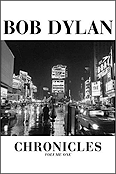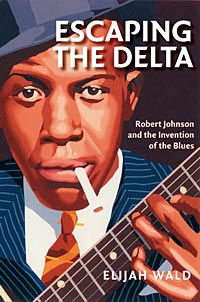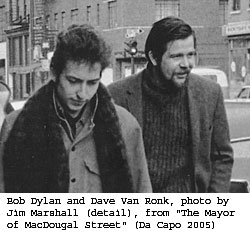Bob Dylan, Dave Van Ronk, and Robert Johnson
[African Guitar] [Other writing] [Music and albums]
I suppose it's not surprising that people have written to ask what I thought of the passage in Chronicles, Volume One in which Bob Dylan writes about Dave Van Ronk's reaction to Robert Johnson. Considering that I dedicated my book on Johnson to Dave, "whose ideas formed the foundation of this work," I was very interested in Dylan's story.
 For
those who haven’t seen it, Dylan writes that John Hammond Sr.
gave him an acetate of Johnson's soon-to-be-released Columbia Records
LP, King of the Delta Blues Singers, and he immediately took
it over to Dave’s place. “I asked Van Ronk if he ever heard
of him. Dave said, nope, he hadn’t . . .” Dylan puts on
the record and is captivated, but Dave is unimpressed. “He kept
pointing out that this song comes from another song and that one song
was an exact replica of a different song.” Dave goes on to play
some Leroy Carr, Skip James and Henry Thomas. Dylan gets the point,
“but Woody had taken a lot of old Carter Family songs and put
his own spin on them, too, so I didn’t think much of whatever
it meant. Dave thought Johnson was okay, that the guy was powerful but
that it was all derivative.” Dylan doesn’t argue, but devotes
the next few weeks to immersing himself in Johnson’s music, and
learning from his songwriting style.
For
those who haven’t seen it, Dylan writes that John Hammond Sr.
gave him an acetate of Johnson's soon-to-be-released Columbia Records
LP, King of the Delta Blues Singers, and he immediately took
it over to Dave’s place. “I asked Van Ronk if he ever heard
of him. Dave said, nope, he hadn’t . . .” Dylan puts on
the record and is captivated, but Dave is unimpressed. “He kept
pointing out that this song comes from another song and that one song
was an exact replica of a different song.” Dave goes on to play
some Leroy Carr, Skip James and Henry Thomas. Dylan gets the point,
“but Woody had taken a lot of old Carter Family songs and put
his own spin on them, too, so I didn’t think much of whatever
it meant. Dave thought Johnson was okay, that the guy was powerful but
that it was all derivative.” Dylan doesn’t argue, but devotes
the next few weeks to immersing himself in Johnson’s music, and
learning from his songwriting style.
Now, there is something wrong with this story but a lot more right, and it provides interesting insights into all three artists. The inaccuracy is that, while Dave would not have heard most of the songs on the LP, he certainly had heard of Robert Johnson. He had been roommates with Sam Charters while Sam was finishing up his book The Country Blues, and had one of the first copies of both it and the accompanying album -- which every blues fan in the folk world bought the instant they were available. The book had a chapter on Johnson, and the LP included Johnson’s “Preachin’ Blues,” and they came out in 1959, two years before the Columbia record.
 That
mistake aside, the gist of Dylan’s story rings true. Before the
Columbia LP, Johnson was not considered a major figure in the blues
world, and neither Dave nor anyone else except some of Johnson’s
old friends in Mississippi and a few 78 collectors had paid much attention
to him. To Dave, as to most blues and jazz listeners, Johnson was a
not particularly distinctive latecomer, still playing the old acoustic
style at a time when the blues world had moved on to Jimmy Rushing with
Count Basie, followed by people like Dinah Washington and Ray Charles.
That
mistake aside, the gist of Dylan’s story rings true. Before the
Columbia LP, Johnson was not considered a major figure in the blues
world, and neither Dave nor anyone else except some of Johnson’s
old friends in Mississippi and a few 78 collectors had paid much attention
to him. To Dave, as to most blues and jazz listeners, Johnson was a
not particularly distinctive latecomer, still playing the old acoustic
style at a time when the blues world had moved on to Jimmy Rushing with
Count Basie, followed by people like Dinah Washington and Ray Charles.
Dave got his start in the jazz world, and his idea of a great singer was Louis Armstrong. He devoted his life to applying what he had learned from Armstrong, Jelly Roll Morton, Bing Crosby, Billie Holiday and Duke Ellington to a blues repertoire that had originally been sung by people whose styles he considered comparatively primitive and archaic. In the mid-1950s, when he first discovered rural blues, he was briefly captivated by Leadbelly’s approach, but he quickly concluded that an Irish guy from Brooklyn sounded silly imitating a black Louisiana country singer, and that in any case a lot had happened since those records were made. To him, the idea of a modern singer phrasing blues as if Armstrong, Billie Holiday, and Ray Charles had not come along was like a modern poet writing Elizabethan sonnets -- not necessarily bad, but pointless. That had already been done very well, and the world was now a different place.
Dave admired Johnson’s records for what they were, but he had nothing to learn from them, so they didn’t interest him much. Non-musicians may have trouble understanding this, but musicians don’t just listen to music for pleasure -- or rather, their pleasure is generally inseparable from their work. When they listen to music (especially the sort of music they play themselves), they are looking for useful ideas, and a very good record that has nothing they can use is often dismissed not because there is anything wrong with it but just because it isn’t useful to them.
Dave’s guitar style was based on the playing of Rev. Gary Davis, an approach that is completely different from Johnson’s. What is more, Dave liked a solid, full sound -- he often described his guitar charts as being like the Ellington band arrangements, over which he sang like a horn soloist -- while Johnson’s playing was all about open spaces and a rhythmic control Dave could not match. He preferred to listen to pianists like Leroy Carr and Jelly Roll Morton, and to adapt their fuller harmonic ideas to the guitar.
Johnson’s singing, likewise, had little or nothing that Dave could use. Basically, Dave wanted to sing blues like Armstrong. He loved interesting harmonies and jazz phrasing. To him, heartfelt passion was something you got from inside -- on a good night, if you were lucky -- but craft was something you could study. Johnson was arguably a deeper, more soulful singer than Armstrong -- though Dave didn’t think so -- but what made Johnson’s vocals great was not something you could learn, while Armstrong’s were like a textbook on how to phrase a lyric.
 Dylan
writes worshipfully of Johnson’s voice and guitar, but only in
passing, and he does not suggest that he learned anything from either.
Indeed, like Dave, he undoubtedly picked up more from Ray Charles --
whom he hardly mentions -- when it came to singing (not to mention Woody
Guthrie, Jack Elliott and Dave himself). But Dylan, unlike Dave, was
a songwriter, and in Johnson he found a model of searing, concise poetry.
Johnson’s songs had never attracted Dave, because they did not
fit his style as a performer.
Dylan
writes worshipfully of Johnson’s voice and guitar, but only in
passing, and he does not suggest that he learned anything from either.
Indeed, like Dave, he undoubtedly picked up more from Ray Charles --
whom he hardly mentions -- when it came to singing (not to mention Woody
Guthrie, Jack Elliott and Dave himself). But Dylan, unlike Dave, was
a songwriter, and in Johnson he found a model of searing, concise poetry.
Johnson’s songs had never attracted Dave, because they did not
fit his style as a performer.
Dylan was not thinking about Johnson’s lyrics as potential material either. But he was learning how to put his own lyrics together, and his approach to songwriting seems to have been revolutionized by Johnson’s example. “I copied Johnson’s words down on scraps of paper so I could more closely examine the lyrics and patterns, the construction of his old-style lines and the free association that he used, the sparkling allegories, big-ass truths wrapped in the hard shell of nonsensical abstraction . . .” It is easy to see how that description leads to “A Hard Rain’s A-Gonna Fall.”
The point of all of this is quite simple: Art is not a contest, or any kind of test. When it came to Dylan and Dave, and their opinions of Robert Johnson, they both looked at what he had to offer and one of them found something useful and the other didn’t. That was not a judgement of Johnson’s work, nor is it a judgement of either of theirs. It was a straightforward case of “You’re right from your side and I’m right from mine.”